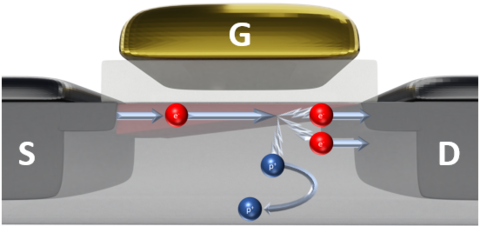
Through a process known as impact ionization, extra electric charges are generated inside transistors (as represented by the red electron and blue “hole” pair in this schematic n-channel metal oxide semiconductor field effect transistor or MOSFET). These pairs break up, and, at low temperatures, some of the positively charged holes are trapped in the transistor body, providing a way to store memory states. This impact ionization process underlies a novel proposed cryogenic memory.
Digital transistors – assembled by the billions in today’s computer chips – act as near-perfect electronic switches. In the “on” position, achieved when an above-threshold voltage is applied to the device, the transistor allows current to flow. When the switch is off, the transistor prevents the flow of current. The on/off positions of the switch translate into the 1s and 0s of digital computation.
Although these 1s and 0s are fundamental to the operation of a computer, complex computations require that the data be stored in memory in order to be useful. In today’s chips, memory relies on another device, in addition to the transistor: a capacitor that stores electric charge. The capacitor is empty when the transistor is switched off and flooded with electric charge when the transistor switches on. The charge on the capacitor then preserves the 1 or 0 of the transistor’s switch state.
Researchers at the National Institute of Standards and Technology (NIST) and their colleagues at Brown University have now observed that at temperatures about three degrees above absolute zero (3K), a transistor can serve as its own memory storage device, obviating the need for a capacitor. By a process known as impact ionization, extra electric charges are generated inside the transistor. At low temperatures, some of these extra charges can be trapped in the transistor body, affecting the flow of current and providing a way to store memory of the “1” state.
The finding, reported online July 29 in Applied Physics Letters, could lead to the development of more compact control circuitry for low-temperature sensors and quantum information devices. For example, cold transistors could interface with and read out the data from proposed solid-state qubits – the quantum analog of the bits (1s and 0s) of a conventional computer, which require temperatures as low as 25 thousandths of a degree above absolute zero.
Because the transistors are standard, readily available silicon components, they could easily be incorporated into computer circuitry at low temperatures, noted study co-author Curt Richter of NIST.
The study began when colleagues from Brown University approached NIST because they wanted to build a magnetic camera, consisting of a sensitive magnetic field sensor array, in order to examine ultrathin materials at cryogenic (ultralow) temperatures. NIST specializes in studying the detailed behavior of computer circuitry, including transistors, at cryogenic temperatures, in order to aid designers of computers.
The NIST-Brown University researchers noticed that when they applied a voltage exceeding 1.3 volts to a cold transistor to switch it to the “on” position, the transistor retained memory of that event even after it was switched off. The memory manifested itself as the amount of current flowing through the transistor when it was in the “off” position. For a given applied voltage, the current in the transistor depended on its history — whether it had recently been switched on or not. The current was markedly different — as much as 10 million times greater — if the transistor had recently been switched on compared to a situation in which the transistor had remained off.
“That makes it possible to create a very compact memory out of a single transistor,” Richter said.
The memory persisted for several minutes, which is a long time compared to the timescale of quantum sensing or computation, “so our device could be useful for memory applications in proposed quantum computing schemes,” Richter added.
He said the study's authors now plan to explore just how high a temperature the transistors can operate at and still retain a built-in memory, as well as the speeds at which the memory can be programmed and erased.
Paper: A. Zaslavsky, C. A. Richter, P. Shrestha, B.D. Hoskins, T. Le, A. Madhavan and J. J. McClelland. Impact ionization-induced bistability in CMOS transistors at cryogenic temperatures for capacitorless memory applications. Applied Physics Letters, vol. 19, issue no. 4, 2021. DOI: 10.1063/5.0060343

